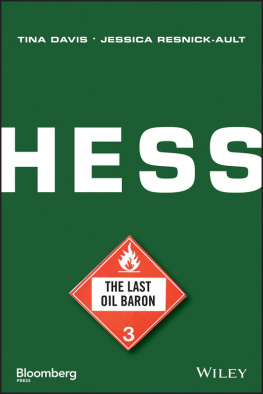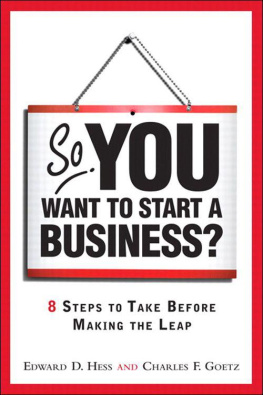
Cover illustration: iStock.com/tfoxfoto
Cover design: Wiley
Copyright 2016 by Tina Davis and Jessica Resnick-Ault. All rights reserved.
Published by John Wiley & Sons, Inc., Hoboken, New Jersey.
Published simultaneously in Canada.
No part of this publication may be reproduced, stored in a retrieval system, or transmitted in any form or by any means, electronic, mechanical, photocopying, recording, scanning, or otherwise, except as permitted under Section 107 or 108 of the 1976 United States Copyright Act, without either the prior written permission of the Publisher, or authorization through payment of the appropriate per-copy fee to the Copyright Clearance Center, Inc., 222 Rosewood Drive, Danvers, MA 01923, (978) 750-8400, fax (978) 646-8600, or on the Web at www.copyright.com. Requests to the Publisher for permission should be addressed to the Permissions Department, John Wiley & Sons, Inc., 111 River Street, Hoboken, NJ 07030, (201) 748-6011, fax (201) 748-6008, or online at http://www.wiley.com/go/permissions.
Limit of Liability/Disclaimer of Warranty: While the publisher and author have used their best efforts in preparing this book, they make no representations or warranties with respect to the accuracy or completeness of the contents of this book and specifically disclaim any implied warranties of merchantability or fitness for a particular purpose. No warranty may be created or extended by sales representatives or written sales materials. The advice and strategies contained herein may not be suitable for your situation. You should consult with a professional where appropriate. Neither the publisher nor author shall be liable for any loss of profit or any other commercial damages, including but not limited to special, incidental, consequential, or other damages.
For general information on our other products and services or for technical support, please contact our Customer Care Department within the United States at (800) 762-2974, outside the United States at (317) 572-3993 or fax (317) 572-4002.
Wiley publishes in a variety of print and electronic formats and by print-on-demand. Some material included with standard print versions of this book may not be included in e-books or in print-on-demand. If this book refers to media such as a CD or DVD that is not included in the version you purchased, you may download this material at http://booksupport.wiley.com. For more information about Wiley products, visit www.wiley.com.
Library of Congress Cataloging-in-Publication Data:
Names: Davis, Tina, 1974 | Resnick-Ault, Jessica, 1980
Title: Hess : the last oil baron / Tina Davis, Jessica Resnick-Ault.
Description: Hoboken, New Jersey : John Wiley & Sons, Inc., [2016] | Series:
Bloomberg Press | Includes bibliographical references and index.
Identifiers: LCCN 2015031845 | ISBN 978-1-118-92344-3 (cloth);
ISBN 978-1-118-92346-7 (ePDF); ISBN 978-1-118-92345-0 (ePub)
Subjects: LCSH: Hess, Leon, 1914-1999. | BusinessmenUnited
StatesBiography. | Petroleum industry and tradeUnited States.
Classification: LCC HD9570.H47 D39 2016 | DDC 338.7/6655092dc23 LC record available at http://lccn.loc.gov/2015031845

Since 1996, Bloomberg Press has published books for financial professionals, as well as books of general interest in investing, economics, current affairs, and policy affecting investors and business people. Titles are written by well-known practitioners, BLOOMBERG NEWS reporters and columnists, and other leading authorities and journalists. Bloomberg Press books have been translated into more than 20 languages.
For a list of available titles, please visit our Web site at www.wiley.com/go/bloombergpress.
Preface
Are there any questions?
The narrow conference room on the first floor of Hess Corporations 29-story downtown Houston office high-rise was quiet. About 100 people were gathered to see the denouement of a four-month battle between the oil companys board and management and a hedge fund agitating for change.
Chief Executive Officer John B. Hess, son of company founder Leon Hess, was facing shareholders in public for the first time since the fund run by Wall Street activist Paul Singer had announced it had acquired a sizable stake in the company and was seeking to alter its course, demanding it sweep out old board members, sell assets, and refocus its corporate strategy. John, newly stripped of his role as chairman, had agreed hours before to allow the dissident shareholder to appoint three nominees to the board after four months of acrimony capped by negotiations that stretched into the early morning. There were no questions.
Thirty-eight minutes into a shareholder meeting that had been preceded by an increasingly nasty series of letters, battling websites, and name-calling between the hedge fund and the company, it was over. Faced with the biggest challenge to his familys leadership since the company was founded in 1933, John Hess had blinked.
That May morning in Houston, shareholders rode the escalator into the Hess conference room. The skyscraper, with more than 800,000 square feet of office space, gleams in the heart of Houstons booming energy corridor. Shortly after it opened in 2010, as if in homage to its fossil-fuelloving largest tenant, wind turbine parts fell off the building. The rooftop wind turbines were quietly removed.
Pieces were falling from the Hess empire, too, and with little fanfare, nine board members were removed to make way for the new nominees and the new chairman. The CEO who took over four years before his fathers death had lost some grip on the company whose expansion he had been witnessing firsthand for all of his 59 years.
The company had managed to continue being operated as a family venture through 80 years, large mergers, multiple missteps, and many triumphs. The brand that Leon Hess built from a single delivery truck in the Great Depression to an ubiquitous green-and-white logo along East Coast roadways, was no longer being run exclusively by the family and a board full of friends.
What defined the company without the Hess family in full control? Just like wind turbines that were removed from atop the Houston office one day, would anyone notice the absence of a Hess at Hess?
Chapter 1
Hess Family
Leon Hesss family story is in many ways a well-worn tale of the American dream: an Eastern European Jewish immigrant comes to the United States, followed by other relatives, starts businesses to try to make a living, and leaves much of the old world behind. The family faced hardships and mishaps common from immigration in the early 1900s, including names distorted by officials who didnt speak their language, housing in crowded immigrant neighborhoods, an inability to use skills from the old country, and bankruptcy. In the second generation, though, the story takes a wild departure: filled with a unique mix of Depression-era creativity, World War II logistical knowledge, and inspiration from a powerful mentor, the youngest son would reimagine his fathers failed business and establish himself as one of the richest men in the country.
In the first decade of the 1900s, immigrant familiesparticularly Jewish onesflooded New York and New Jersey, overflowing available houses, apartments, and tenements from the Lower East Side to the Jersey Shore and beyond. They joined the garment industry or started small businesses as tailors, milliners, and peddlers.
The Hess familys story is in many ways indistinguishable from dozens of others: Mores Hess, a kosher butcher, came from Lithuania with little in 1904a year that brought more than 1 million people to the United States. Like Mores, three quarters of all immigrants were bound for the New York area, while others disembarked at other large East Coast ports: Boston, Baltimore, and Philadelphia. His ship left Europe from Bremen, a popular departure point on Germanys northern coast, and was called the S.S. Kaiser Wilhelm der Grosse, named for the first emperor to rule a united Germany. The other passengers were mostly men, largely ranging in age from 27 to 56. Many were German, but the ship also carried Russians, Hungarians, and people of other nationalities. They were merchants and workers, but also an actor and a jurist. The ships manifest appears slapdash, with lots of shorthand and empty columns, like many others of its time, a product of the sheer quantity of emigrant paperwork that faced European shipping lines. The manifest suggests that Mores carried over $50, and had never been in the United States before this passage. The exact reasons for his departure were not recorded, but can be imagined as the same ones that propelled many to leave Lithuania: religious freedom, the prospect of education for his children, and economic betterment. The wave of immigration from Lithuania to the United States had many drivers, and began before Mores headed to Bremen. The 1861 abolition of serfdom had increased the number of free people, who were able to leave the country at the same time, and the rising availability of railroads and other transit made it easier for Lithuanians to leave. A depressed farm economy and increased control from Russia also pushed immigrants out.
Next page














